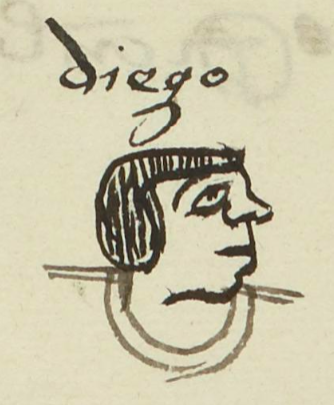tlacotli (MH606v)
This black-line drawing for the simplex noun, tlacotli (enslaved person), shows a man's head in profile, facing toward the viewer's right, and around his neck is a round (likely wooden) collar attached to a horizontal pole or stick. This restraining collar was how people were marked as enslaved, and it was supposed to inhibit their escape. The absence of anything more than the name "Diego," suggests that he was enslaved, as opposed to being the middle child, "Tlaco." Besides, birth order names were more common for girls and women.
Stephanie Wood
The rods (tlacotl) attached to the collars were up to about a yard or meter in length. See Ian Mursell's discussion of this wooden collar in Mexicolore. See also his further discussion of slavery.
Stephanie Wood
diego
Diego
Stephanie Wood
1560
Jeff Haskett-Wood
slaves, enslaved persons, slavery, esclavizados

tlaco(tli), enslaved person, https://nahuatl.wired-humanities.org/content/tlacotli
tlaco, half, or middle child, https://nahuatl.wired-humanities.org/content/tlaco
una persona esclavizada
Stephanie Wood
Matrícula de Huexotzinco, folio 606v, World Digital Library, https://www.loc.gov/resource/gdcwdl.wdl_15282/?sp=295st=image.
This manuscript is hosted by the Library of Congress and the World Digital Library; used here with the Creative Commons, “Attribution-NonCommercial-ShareAlike 3.0 License” (CC-BY-NC-SAq 3.0).






